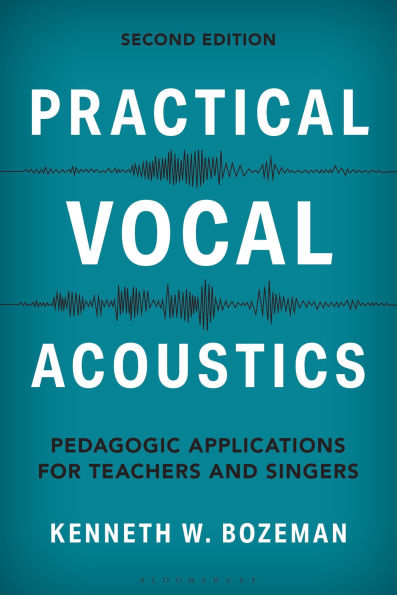Kenneth Bozeman distills the most important vocal acoustic principles and insights for contemporary teachers and singers.
Scientific knowledge of vocal acoustics has grown exponentially in the last 80 years. With sophisticated yet inexpensive sound analysis technology, more voice teachers are curious about the value of vocal acoustics for the studio and see the need to understand it for more efficient, science-informed pedagogy. This 2nd edition provides vital updates, including:
- Updated notational designations
- Inclusion of the transient theory of voice alongside the source-filter theory
- Updated gender designations
- More details about treble voice acoustics and pedagogy
- More details about vocal styles other than classical
- Updated information on the perception of sound
With concise and easy-to-understand language, Bozeman translates complex concepts into practical tips and strategies that can be used both in teaching and singing. Unlike many other singing texts, this book focuses on the perception, knowledge, and use of vocal acoustics as an especially powerful avenue for training vocal efficiency. Bozeman addresses topics including the relevance of perception of sound and sensation to singing, how theories of vocal resonance guide function, the pedagogic implications of tube acoustics, resonances and their interactions with harmonics, acoustic vocal registers and registration, effective passaggio training, the acoustics of belting, and acoustic technology useful for the studio.
Also included are vocal exercises implementing these concepts.
1115465183
Scientific knowledge of vocal acoustics has grown exponentially in the last 80 years. With sophisticated yet inexpensive sound analysis technology, more voice teachers are curious about the value of vocal acoustics for the studio and see the need to understand it for more efficient, science-informed pedagogy. This 2nd edition provides vital updates, including:
- Updated notational designations
- Inclusion of the transient theory of voice alongside the source-filter theory
- Updated gender designations
- More details about treble voice acoustics and pedagogy
- More details about vocal styles other than classical
- Updated information on the perception of sound
With concise and easy-to-understand language, Bozeman translates complex concepts into practical tips and strategies that can be used both in teaching and singing. Unlike many other singing texts, this book focuses on the perception, knowledge, and use of vocal acoustics as an especially powerful avenue for training vocal efficiency. Bozeman addresses topics including the relevance of perception of sound and sensation to singing, how theories of vocal resonance guide function, the pedagogic implications of tube acoustics, resonances and their interactions with harmonics, acoustic vocal registers and registration, effective passaggio training, the acoustics of belting, and acoustic technology useful for the studio.
Also included are vocal exercises implementing these concepts.
Practical Vocal Acoustics: Pedagogic Applications for Teachers and Singers
Kenneth Bozeman distills the most important vocal acoustic principles and insights for contemporary teachers and singers.
Scientific knowledge of vocal acoustics has grown exponentially in the last 80 years. With sophisticated yet inexpensive sound analysis technology, more voice teachers are curious about the value of vocal acoustics for the studio and see the need to understand it for more efficient, science-informed pedagogy. This 2nd edition provides vital updates, including:
- Updated notational designations
- Inclusion of the transient theory of voice alongside the source-filter theory
- Updated gender designations
- More details about treble voice acoustics and pedagogy
- More details about vocal styles other than classical
- Updated information on the perception of sound
With concise and easy-to-understand language, Bozeman translates complex concepts into practical tips and strategies that can be used both in teaching and singing. Unlike many other singing texts, this book focuses on the perception, knowledge, and use of vocal acoustics as an especially powerful avenue for training vocal efficiency. Bozeman addresses topics including the relevance of perception of sound and sensation to singing, how theories of vocal resonance guide function, the pedagogic implications of tube acoustics, resonances and their interactions with harmonics, acoustic vocal registers and registration, effective passaggio training, the acoustics of belting, and acoustic technology useful for the studio.
Also included are vocal exercises implementing these concepts.
Scientific knowledge of vocal acoustics has grown exponentially in the last 80 years. With sophisticated yet inexpensive sound analysis technology, more voice teachers are curious about the value of vocal acoustics for the studio and see the need to understand it for more efficient, science-informed pedagogy. This 2nd edition provides vital updates, including:
- Updated notational designations
- Inclusion of the transient theory of voice alongside the source-filter theory
- Updated gender designations
- More details about treble voice acoustics and pedagogy
- More details about vocal styles other than classical
- Updated information on the perception of sound
With concise and easy-to-understand language, Bozeman translates complex concepts into practical tips and strategies that can be used both in teaching and singing. Unlike many other singing texts, this book focuses on the perception, knowledge, and use of vocal acoustics as an especially powerful avenue for training vocal efficiency. Bozeman addresses topics including the relevance of perception of sound and sensation to singing, how theories of vocal resonance guide function, the pedagogic implications of tube acoustics, resonances and their interactions with harmonics, acoustic vocal registers and registration, effective passaggio training, the acoustics of belting, and acoustic technology useful for the studio.
Also included are vocal exercises implementing these concepts.
31.45
In Stock
5
1

Practical Vocal Acoustics: Pedagogic Applications for Teachers and Singers
216
Practical Vocal Acoustics: Pedagogic Applications for Teachers and Singers
216Related collections and offers
31.45
In Stock

Product Details
| ISBN-13: | 9798765159965 |
|---|---|
| Publisher: | Bloomsbury Publishing |
| Publication date: | 09/04/2025 |
| Series: | National Association of Teachers of Singing Books |
| Sold by: | Barnes & Noble |
| Format: | eBook |
| Pages: | 216 |
| File size: | 3 MB |
About the Author
From the B&N Reads Blog
